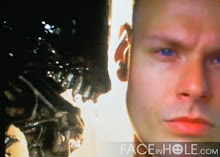
I'm quite surprised at the negative feedback that's surrounding Jim Jarmusch's latest effort, The Limits of Control. Roger Ebert himself has penned quite the asinine review. True, Jarmusch's pacing tends to lull us away from the narrative (I thought of how I was out of mayo several times, and am now realizing I still need to buy some), however, if you know what to generally expect from Jarmusch (which Ebert should) then you might be in for an engaging, and certainly not unfulfilling time with his latest effort---though it is the fodder of what makes up film criticism. Feeling much like a more whimsical turn by David Lynch, the film is centered around a man, who, we come to feel, is up to no good and is on a mission that we can only assume will end with an assassination or worse. This man is played by the stoic Isaach De Bankole, who thankfully, is an engaging screen presence--dialogue is a bit limited and there are several stretches where we are just watching Bankole, err, travel all over Spain. Some major international players are peppered throughout the film, all of whose appearances are virtually cameos and each repeating the same concept dialogue, more or less. Personal favorites of mine Alex Descas, Hiam Abbass, John Hurt, Gael Garcia Bernal---"the universe has no boundaries and no edges," "Reality is arbitrary," and something about men that think they're bigger than it and how they should go to the cemetery to see what life is all about. And what's life about? Well, death, of course. What I couldn't seem to get out of my head was the title and how it fit into the mix---who has control, who's being limited? I believe Jarmusch is making an obvious statement about the limits of narrative control, the limits of artistic control---cinema and art are featured in this film, each mediums in their own right, and each with boundaries and edges---Tilda Swinton's engaging turn as a Lady GaGa-ian creature references Orson Welle's The Lady From Shanghai (1947) and how that classic noir didn't make any sense---she talks of Rita Hayworth's notoriously dyed blonde locks and of the famous fun-house climax with the shattered mirrors. Jarmusch's film is asking us to look at these themes, of shattered mirrors, tropes, doubles, controls. Bankole does a lot of sitting in cafes in order to meet his "contacts" (who he continually will exchange different colored matchboxes with the "boxeur" on it) and he always orders two single espressos, served in different cups, only one of which he will ever drink. He continually visits a museum, the paintings imitating the people he will be introduced to. The world is a mirror, and we, as humans, have limited control over our destinies, just as film characters have limited control over their images, their projected selves, their mirrors. Why do we love cinema? Because in a way, cinema is a mirror into us, different angles of us, different worlds, all open to interpretation, another facet we have no control over---how symbols and images are interpreted. Tilda Swinton's character likes old movies, citing instances where you know a film was good if you find yourself questioning whether it was a film, a dream, or something you experienced yourself---and why is not observing the experience of another not akin to experiencing something yourself? The Limits of Control, you see---the more I think about it, the more I really loved this film. Also, shout out to Paz de la Huerta, who's is weird and naked throughout all her scenes. And yes, Bill Murray is entertaining in his scene, as well. And if you think you're bigger and better than it all, go to the cemetary. That's what life is about---that's where we all end up.

No comments:
Post a Comment